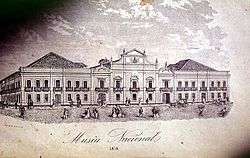National Museum of Brazil
Coordinates: 22°54′20.40″S 43°13′33.98″W / 22.9056667°S 43.2261056°W
|
The National Museum | |
| Established | 1818 |
|---|---|
| Location | Quinta da Boa Vista in Rio de Janeiro, Brazil |
| Type | Natural history, ethnology and archaeology |
| Website | www.museunacional.ufrj.br |
The National Museum of Brazil (Portuguese: Museu Nacional) is a museum and research institution, located in the Quinta da Boa Vista park in the city of Rio de Janeiro, Brazil.
History
The National Museum was established by the King of Portugal Dom João VI (1769–1826) in 1818 with the name of Royal Museum, in an initiative to stimulate scientific research in Brazil, which until then was an immense and wild colony, practically unexplored by science. Initially the Museum sheltered botanical and animal specimens, especially birds, what caused the old building where it was located in center of Rio de Janeiro, to be known by the population as the "House of the Birds".

After that, with the marriage of D. João VI's son and Brazil's first Emperor, Dom Pedro I (1798–1834) with Princess Leopoldina of Austria, the Museum started to attract the greatest European naturalists of the 19th century, such as Maximilian zu Wied-Neuwied (1782–1867), Johann Baptist von Spix (1781–1826) and Carl Friedrich Philipp von Martius (1794–1868). Other European researchers who explored the country, such as Augustin Saint-Hilaire (1799–1853) and the Baron von Langsdorff (1774–1891), contributed for the collections of the Royal Museum.
By the end the 19th century, reflecting the personal preferences of Emperor Dom Pedro II (1825–1891), the National Museum started to invest in the areas of the anthropology, paleontology and archaeology. The Emperor himself, who was an avid amateur scientist and enthusiastic supporter of all branches of science, contributed with several of the collections of the art of Ancient Egypt, botanical fossils, etc., which he acquired during many of his trips abroad. In this way, the National Museum was modernized and became the most important museum of Natural History and Human Sciences of South America. Edmund Roberts visited the museum in 1832, noting that the museum only had three open rooms at that time, and that the closed rooms were "sadly plundered of its contents by Don Pedro."[1]
D. Pedro II was well aware of the shortage of true scientists and naturalists in Brazil. He fixed this problem by inviting foreign scientists to come to work at the Museum. The first to come was Ludwig Riedel (1761–1861), a German botanist who had participated in Baron von Langsdorff's famed expedition to Mato Grosso from 1826 to 1828. Other scientists to come were: German chemist Theodor Peckolt and American geologist and paleontologist Charles Frederick Hartt (1840-1878). In the following years the Museum gradually became known so it continued to attract several foreign scientists who wished to achieve scientific stature with their work in Brazil, such as Fritz Müller (1821–1897), Hermann von Ihering (1850–1930), Carl August Wilhelm Schwacke (1848–1894), Orville Adalbert Derby (1851–1915), Émil August Goeldi (1859–1917), Louis Couty (1854–1884) and others, all fired by museum director Ladislau Netto when the emperor was deposed.

The Emperor was still a very popular figure when he was deposed by a military coup in 1889, so the republicans tried to erase the symbols of the Empire. One of these symbols, the Paço de São Cristóvão, the official residence of the emperors in the Quinta da Boa Vista, became vacant; therefore, in 1892, the National Museum, with all its collections, valuables and researchers, was transferred to this palace, where it stays until today.
In 1946, the Museum’s management was passed to the University of Brazil, currently the Federal University of Rio de Janeiro. The researchers and their offices and laboratories occupy a good part of the Palace and other buildings erected at Botanical Gardens (Horto Florestal), in the Quinta da Boa Vista park. There, one can find one of the largest scientific libraries of Rio. Currently, the National Museum offers graduate courses in the following areas: Anthropology and Sociology, Botany, Geology and Paleontology, and Zoology.
Collections
The Museum shelters one of the largest exhibits of the Americas, consisting of animals, insects, minerals, aboriginal collections of utensils, Egyptians mummies and South American archaeological artifacts, meteorites, fossils and many other findings.
See also
| Wikimedia Commons has media related to Museu Nacional, Rio de Janeiro. |
- Paço de São Cristóvão, the historic palace that houses the National Museum
- National Historical Museum of Brazil
References
- ↑ Roberts, Edmund (1837). Embassy to the Eastern Courts of Cochin-China, Siam, and Muscat. New York: Harper & Brothers. p. 25.
External links
- National Museum website
- The National Museum and its European employees Jens Andermann
- The National Museum at Rio de Janeiro Jens Andermann
|